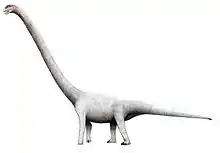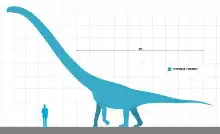Omeisaurus
Omeisaurus (meaning "Omei lizard") is a genus of sauropod dinosaur from the Middle Jurassic Period (Bathonian-Callovian stage) of what is now China. Its name comes from Mount Emei, where it was discovered in the lower Shaximiao Formation of Sichuan Province.[1]
| Omeisaurus | |
|---|---|
 | |
| O. tianfuensis on display in Hong Kong | |
| Scientific classification | |
| Kingdom: | Animalia |
| Phylum: | Chordata |
| Clade: | Dinosauria |
| Clade: | Saurischia |
| Suborder: | †Sauropodomorpha |
| Clade: | †Sauropoda |
| Clade: | †Eusauropoda |
| Family: | †Mamenchisauridae |
| Genus: | †Omeisaurus Young, 1939 |
| Type species | |
| †Omeisaurus junghsiensis Young, 1939[1] | |
| Species | |
Like other sauropods, Omeisaurus was herbivorous and large. It measured 20.2 metres (66 ft) long, and weighed 9.8 tonnes.[4]
Discovery

Omeisaurus was first described in 1939. It was named after the sacred mountain Omeishan, which is where the first fossil example of Omeisaurus was found.[1] Most skeletons of Omeisaurus were found in the 1970s and 1980s, during the great “Chinese dinosaur rush”. There have been eight species of Omeisaurus named so far: O. junghsiensis,[1] O. changshouensis,[2] O. fuxiensis, O. tianfuensis,[5] O. luoquanensis, O. maoianus, O. jiaoi, and O. puxiani.[6] All of these but the last two were named after the locations where they were found. O. fuxiensis was the smallest species, measuring around 35 feet (11 m) long. O. tianfuensis had the longest neck of the genus, around 30 feet (9.1 m) long. The only dinosaur with a longer neck was Mamenchisaurus. Tail clubs have in 1988/1989 been referred to Omeisaurus tianfuensis,[7] but Paul Upchurch in 2004 considered them possible Shunosaurus clubs.[8][9] In their paper on Qijianglong, Xing et al. (2015) considered O. maoianus more closely related to Mamenchisaurus than to O. tianfuensis, a proposal supported by the cladistic analysis of Ren et al. (2018).[10][11]
Mounted skeletons of Omeisaurus are on display at the Zigong Dinosaur Museum in Zigong, Sichuan Province and at Beipei Museum, near Chongqing, both in China.
Classification

It was once classified as a member of the family Cetiosauridae, which had long been a wastebasket taxon. The species O. fuxiensis is sometimes confused with Zigongosaurus, but the two are based on different material despite having the same species name.
Omeisaurus was formerly assigned to Euhelopodidae.[1] However, it and other Jurassic sauropods from Asia formerly assigned to Euhelopodidae are now placed in the separate family Mamenchisauridae.
The cladogram below shows a possible phylogenetic position:[12]
| Sauropoda |
| |||||||||||||||||||||||||||||||||||||||||||||||||||||||||||||||
Paleoecology
Omeisaurus lived in dense forests. Different species of Omeisaurus sometimes shared habitats with each other (O. junghsiensis and O. tianfuensis, for example). In addition to other species of Omeisaurus, Shunosaurus and Datousaurus are also known from the Xiashaximiao Formation, while Mamenchisaurus is present in the Shangshaximiao Formation. Yangchuanosaurus is a large theropod from the Shangshaximiao, and it probably preyed on sauropods. The smaller Xuanhanosaurus was also present. In the Xiashaximiao, another theropod, Gasosaurus, was also present, as was the herbivorous stegosaur Huayangosaurus. The latter probably did not compete with sauropods for food.[9]
References
- Young, C.C. (1939). "On a New Sauropoda, with Notes on Other Fragmentary Reptiles from Szechuan". Bull Geol Soc China. 19: 279–315. doi:10.1111/j.1755-6724.1939.mp19003005.x.
- Young, C.C. (1958). "New sauropods from China" (PDF). Vertebrata PalAsiatica. 2 (1): 1–29.
- Chao Tan; Ming Xiao; Hui Dai; Xu-Feng Hu; Ning Li; Qing-Yu Ma; Zhao-Ying Wei; Hai-Dong Yu; Can Xiong; Guang-Zhao Peng; Shan Jiang; Xin-Xin Ren; Hai-Lu You (2020). "A new species of Omeisaurus (Dinosauria: Sauropoda) from the Middle Jurassic of Yunyang, Chongqing, China fauna". Historical Biology: An International Journal of Paleobiology. in press. doi:10.1080/08912963.2020.1743286.
- Mazzetta, G.V.; et al. (2004). "Giants and Bizarres: Body Size of Some Southern South American Cretaceous Dinosaurs". Historical Biology. 16 (2–4): 1–13. CiteSeerX 10.1.1.694.1650. doi:10.1080/08912960410001715132.
- X. He, K. Li, K. Cai and Y. Gao. (1984). "Omeisaurus tianfuensis—a new species of Omeisaurus from Dashanpu, Zigong, Sichuan". Journal of Chengdu College of Geology 1984 (suppl. 2): 13-32
- JIANG Shan, LI Fei, PENG Guang-Zhao, & YE Yong (2011). A new species of Omeisaurus from the Middle Jurassic of Zigong, Sichuan. Vertebrata PalAsiatica 49(2): 185-194. http://www.ivpp.cas.cn/cbw/gjzdwxb/xbwzxz/201105/P020110530509590205314.pdf
- Dong Zhiming, Peng Guangzhao and Huang Daxi. 1988. "The Discovery of the bony tail club of sauropods". Vertebrata PalAsiatica 27 (3): 219-224
- Upchurch, Paul, Paul M. Barrett and Peter Dodson. 2004. "Sauropoda". pp. 259-322 in D. B. Weishampel, P. Dodson and H. Osmólska (eds.), The Dinosauria, 2nd edition. University of California Press, Berkeley and Los Angeles. p 301
- Paul, G.S. (2010). "Sauropodomorphs". The Princeton Field Guide to Dinosaurs. Princeton: Princeton University Press. p. 244. ISBN 9780691167664.
- Xing LD, Miyashita T, Zhang JP, Li DQ, Ye Y, Sekiya T, Wang FP, Currie PJ. 2015b. A new sauropod dinosaur from the Late Jurassic of China and the diversity, distribution, and relationships of mamenchisaurids. Journal of Vertebrate Paleontology. 35 (1):e889701.
- a b Xin-Xin Ren; Jian-Dong Huang; Hai-Lu You (2018). "The second mamenchisaurid dinosaur from the Middle Jurassic of Eastern China". Historical Biology: An International Journal of Paleobiology. in press. doi:10.1080/08912963.2018.1515935.
- J.A. Wilson, 2002, "Sauropod dinosaur phylogeny: critique and cladistic analysis", Zoological Journal of the Linnean Society 136: 217-276
- Dong Zhiming (1988). Dinosaurs from China. China Ocean Press, Beijing & British Museum (Natural History). ISBN 978-0-565-01073-7.
- Britt, Carpenter et al. (2002). Encyclopedia of Dinosaurs.. Publications international, Ltd., Lincolnwood Illinois.. ISBN 0-7853-5561-8
- The Middle Jurassic dinosaur fauna from Dashanpu, Zigong, Sichuan. Volume 4. Sauropod dinosaurs (2). Omeisaurus tianfuensis. He, X., Li, K. and Cai, Sichuan Publishing House of Science and Technology, Chengdu ; 1-143 (1988).
- The dinosaurian remains from Sichuan Basin, China. Dong, Z., Zhou, S. and Zhang, Y. PALAEONTOLOGIA SINICA SERIES C (No. 23) i-iii; 1-145 (1983).













